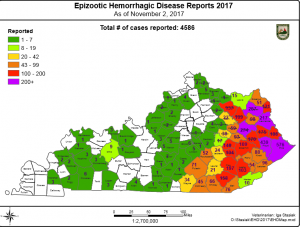 The recent cold snap experienced across Kentucky effectively ended the state’s worst outbreak of epizootic hemorrhagic disease in white-tailed deer in a decade.
The recent cold snap experienced across Kentucky effectively ended the state’s worst outbreak of epizootic hemorrhagic disease in white-tailed deer in a decade.
Epizootic hemorrhagic disease (EHD) is a viral disease transmitted to deer by biting flies or midges. It does not affect people or pets, and outbreaks cease at the first frost, which kills the bugs.
The Kentucky Department of Fish and Wildlife Resources receives and confirms EHD deer mortalities each year but the outbreak this year was severe by comparison. The department started receiving reports of sick or dead deer in some east Kentucky counties in July. August brought confirmation that a common strain of the EHD virus was to blame.
The department encouraged the public to report suspected cases, and the public responded. Kentucky Fish and Wildlife fielded 1,822 individual reports and documented 4,586 suspected EHD cases through phone calls and an online reporting system.
“Kentucky Fish and Wildlife would like to thank the public for its assistance,” said Dr. Iga Stasiak, state wildlife veterinarian with Kentucky Fish and Wildlife. “The incredible response we received was invaluable in helping us gauge the extent and intensity of this year’s severe outbreak. The public’s feedback through those outlets helped biologists monitor the situation in real-time and generate incredibly helpful maps.”
This year’s outbreak affected multiple states across the Appalachian Plateau. In Kentucky, it was primarily confined to counties along and south of Interstate 64 and east of Interstate 75. The epicenter of the outbreak in Kentucky appeared to be in Floyd and Pike counties.
The severity of this year’s outbreak in east Kentucky is comparable to that seen in other parts of the state in 2007. While EHD can cause significant regional population die-offs, populations recover with time, Stasiak said.
“The herd is resilient,” said Gabe Jenkins, deer program coordinator with Kentucky Fish and Wildlife. “We had probably the highest densities of deer that we’ve ever seen in that part of the state. Yes, it knocked them back pretty hard but the population will rebound.”
Herd estimates after the 2016-17 hunting season pegged the statewide deer population at about 850,000 animals.
Kentucky’s deer seasons are continuing as scheduled this year.
“Department biologists will be looking closely at harvest data and monitoring the deer herd ahead of next year’s hunting season,” Stasiak said. “We will also be monitoring deer at several check stations throughout the hunting season to identify deer that may have been exposed to the disease and assess the degree of immunity in the herd.”
Although EHD is not transmissible to people, the department reminds hunters to avoid eating animals that appear to be sick and asks that sick deer be reported to the department either by calling 1-800-858-1549 between 8 a.m.-4:30 p.m. (Eastern) weekdays or contacting their local private lands or public lands biologist, depending on where the animal was observed.
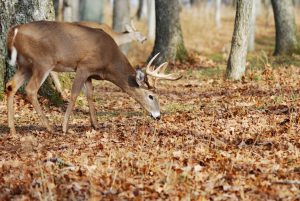
Photo: Kevin Kelly/Kentucky Department Fish and Wildlife
A burst of fall colors, frosty mornings and an uptick in deer activity recently are encouraging and telling signs for hunters.
The season that contributes the greatest percentage of Kentucky’s annual deer harvest and fills many freezers with protein-rich venison is almost here.
Modern gun deer season opens statewide Nov. 11, 2017.
“Opening day should be spot on,” said Gabe Jenkins, deer program coordinator for the Kentucky Department of Fish and Wildlife Resources. “Our gun hunters should have some fantastic deer activity. The start of the season falls early this year. It touches on the end of the chase period and continues into the peak of the rut. We should see some good movement early and late in the season.”
Kentucky’s modern gun deer season is designed to coincide with the peak of fall breeding, known as the rut. It runs for 16 consecutive days in Zones 1 and 2 and for 10 consecutive days in Zones 3 and 4.
County zone assignments are published in the annual Kentucky Hunting and Trapping Guide, available on the department’s website at fw.ky.gov and where licenses and permits are sold. The guide also provides information about license and permit requirements, hunter education and hunter orange requirements, bag limits and legal equipment for deer hunting. Also available on the department’s website is a detailed list of frequently asked questions about deer hunting in Kentucky. Type “Deer Season FAQs” into the search box on the homepage to access it.
Hunters in Kentucky have taken more than 130,000 deer annually over the past five seasons. The 2016-17 tally was the third highest on record with the modern gun season harvest accounting for more than 70 percent of that figure.
This year, the modern gun season harvest will provide biologists additional data to further assess the scope and impact of the outbreak of epizootic hemorrhagic disease (EHD) in eastern Kentucky.
As of Nov. 2, Kentucky Fish and Wildlife had received reports of more than 4,500 sick or dead deer across the state since mid-July. The outbreak was confined primarily to counties east of Interstate 75 and along and south of Interstate 64.
EHD is a virus spread by small biting flies or midges. A recent cold snap effectively ended the outbreak since frost kills the insects that carry the disease.
The virus is not transmissible to people and the meat is safe to eat. In any year, hunters are advised to avoid eating the meat from animals that appear to be overtly sick.
Hunters concerned about hunting elsewhere in the state should have no reservations whatsoever, Jenkins said. The herd remains robust.
“We’ve got a lot of deer,” he said. “I look for it to be just as strong in the rest of the state as it has been in recent years. We had a good fawn year last year, good acorns last year, a mild winter and nice summer. All factors for good survival, good antler production. Lots of goods in there.”
The statewide deer harvest from September’s record opening weekend of archery season through October was up compared to 2016. Harvest reports from the youth-only gun and early muzzleloader seasons in October were down.
A middling mast crop could play to the hunter’s favor. This year’s statewide mast survey found about a third of white oaks with acorns. Red oak acorn production was better at 63 percent. White oak acorns are the first choice for deer because they are sweeter and more palatable to deer than red oak acorns, which have higher tannic acid.
“If you find a white oak with acorns, be on it,” Jenkins said. “During the early muzzleloader season, two does came right underneath me. There was a red oak tree and a white oak tree and one of the does was just sniffing around trying to find those white oak acorns and passing up those red oak acorns. She’d find one and crunch, crunch, crunch.”
In addition to the hunter orange and hunter education requirements, as well as following the guidelines for safe handling of firearms, hunter safety during the modern gun season also extends to the use of tree stands.
Serious accidents can be prevented by following the manufacturer’s instructions for installation, use and maintenance of tree stands.
Hunter education classes offered by Kentucky Fish and Wildlife cover the basics of tree stand safety. Olivia Dangler, a conservation educator with the department, said hunters must not let their guard down.
“Do not let your excitement cause you to forget about safety,” she said. “It does not matter how good of a climber you are, or if you think it will never happen to you, always wear a harness and stay clipped into the tree because it can save your life.
“Inspect your equipment prior to use and wear a full body harness whether you are hanging, practicing or hunting from a tree stand. Once you leave the ground, your harness should be connected to the tree. According to the International Hunter Education Association, 99 percent of fall victims injured were not attached to the tree.”
Tree stands and harnesses are rated to support up to their stated weight capacities.
Keep your hands free and never carry equipment while climbing up to or down from a tree stand. Use a haul line to raise or lower equipment instead.
“Firearms should be unloaded with the safety on,” Dangler said. “Attach the haul line to the sling or stock so the muzzle is pointed down when pulling it up to you or lowering it to the ground. If using a bow while hunting, make sure it is unloaded before attaching the haul line and have arrows secured in covered quiver.”
An online tree stand safety course can provide a good introduction or refresher. A free, interactive course is available through the Treestand Manufacturer’s Association website at tmastands.com.
Hunters should choose trees that are straight and large enough to adequately support their tree stands. Avoid ash trees. The emerald ash borer has decimated the ash tree population in recent years. Any ash trees still standing should be considered unsuitable. Knowing where ash trees are in proximity to your location is another important consideration. Dead limbs can break under their own weight without warning.
Hunters who are still looking for a place to hunt can find information about public lands on the department’s website. On any wildlife management area that allows gun deer hunting, anyone hunting from inside a ground blind must now attach a hat or vest made of solid, unbroken hunter orange material to the outside so it is visible from all sides. Hunter orange clothing requirements still apply for anyone inside the blind.
Once you know where you will be hunting, it’s always a good idea to let a family member or friend know where you will be that day and when you expect to return.
“Get out there and go,” Jenkins said. “The full-swing rut is definitely here.”
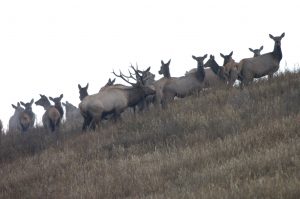
Elk photos from Starfire WMA Oct. 27, 2005. Photos taken by Dave Baker.
The Kentucky Fish and Wildlife Commission modified the elk voucher cooperator and elk restoration permit program and boating regulations at its quarterly meeting Sept. 8.
The Commission recommends all hunting, fishing and boating regulations for approval by the General Assembly and approves all expenditures by the Kentucky Department of Fish and Wildlife Resources. All recommendations must be approved by legislators before they become law.
In wildlife-related business, the Commission proposed modifying the point system used for the Voucher Cooperator Elk Permit and the Elk Restoration Permit programs in an effort to increase landowner participation. Commissioners voted to reduce the number of points needed by participating landowners to receive an elk permit. Commission members also recommended requiring elk guides to report elk wounded by clients.
In other wildlife-related business, commissioners proposed adding a third quota fox hunting field trail at Clay Wildlife Management Area (WMA) in Nicholas County for the last weekend in February. They also recommended changes to testing and permitting requirements for falconry.
In boating-related business, the commission recommended creating a maximum centerline length of 24 feet for monohull boats with seating for at least eight passengers on the following lakes: Guist Creek Lake in Shelby County, Cedar Creek Lake in Lincoln County, Lake Beshear in Caldwell and Christian counties and Lake Malone in Muhlenberg, Todd and Logan counties.
If approved by legislators, the boating regulation proposed at the meeting would take effect March 1, 2018.
The next Kentucky Fish and Wildlife Commission meeting is currently scheduled for 8:30 a.m. (Eastern time), Friday, Dec. 8, 2017. Meetings are held in Frankfort at Kentucky Fish and Wildlife headquarters, 1 Sportsman’s Lane. Commission meetings are open for the public.
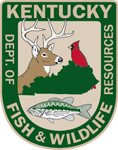 The Kentucky Fish and Wildlife Commission unanimously recommended today that the department increase prices for some resident Kentucky hunting and fishing licenses.
The Kentucky Fish and Wildlife Commission unanimously recommended today that the department increase prices for some resident Kentucky hunting and fishing licenses.
The Commission is the guiding body for the Kentucky Department of Fish and Wildlife Resources. It took the action during its September quarterly meeting. It will be the first resident license price increase in more than a decade, and the first increase of the senior and disabled sportsman’s licenses since their inceptions in 1999.
The Commission recommends all hunting, fishing and boating regulations for approval by the General Assembly and approves all expenditures by Kentucky Fish and Wildlife. All recommendations must be approved by legislators before they become law.
Kentucky Fish and Wildlife relies primarily on license sales and federal excise taxes from the sale of hunting and fishing equipment for its revenue. It does not receive state General Fund money, such as those derived from income taxes or property taxes. The Department manages more than 600,000 acres for public use and stocks nearly 10 million fish each year. Hunting, fishing, boating and wildlife watching generate an estimated $5.9 billion to Kentucky’s economy each year.
The Commission’s recommendation includes resident hunting licenses, fishing licenses, combination hunting/fishing licenses, senior and disabled sportsman’s licenses and joint fishing licenses for spouses.
“Periodic license price increases are necessary to keep pace with inflation and general costs of living,” said Commission Chairman Jimmy Bevins. “We usually project that an increase will last five years, but solid fiscal management historically has allowed us to make them last much longer.”
The Department’s last three resident rate changes happened in 1992, 1999 and 2007. License and permit fees for non-residents increased to help offset rising operational costs in 2014, but resident fees remained unchanged at the time.
Commission members said they took the action to help offset the rising costs of operating the Department’s three summer camps and the Salato Wildlife Education Center. In addition, increased revenue also will be utilized for increased conservation law enforcement efforts across the Commonwealth.
The three summer camps annually graduate more than 5,000 youth. The Salato Wildlife Education Center, located on the main Kentucky Fish and Wildlife campus, hosts more than 50,000 visitors each year.
“These programs are one main reason why Kentucky continues to see robust participation in hunting and fishing despite decreases seen in surrounding states,” said Kentucky Fish and Wildlife Commissioner Gregory K. Johnson. “Our children are our future sportsmen and sportswomen, and our future leaders.
“These license increases help the Department maintain a commitment and solid investment in outdoor education of our youth,” said Johnson. “Revenue also will support a more complete law enforcement presence across the state, and improved law enforcement recruitment and retention.”
“We operate almost entirely from user fees derived from hunting and fishing license sales, and federal excise taxes generated by the sale of hunting, fishing and shooting equipment and ammunition,” said Bevins. “Other Kentucky state agencies are largely funded by General Fund tax dollars.”
“The new rates for residents would not happen until the 2018 license year,” said Bevins, “so that means we will have made our last increase last for 11 years – more than twice the original projection.”
The Commission voted to increase a resident hunting license from its current $20 to $27, a resident fishing license from $20 to $23, a combination resident hunting/fishing license from $30 to $42 and the resident joint fishing license for spouses from $36 to $42.
Currently, the senior and disabled sportsman’s licenses provide $165 worth of licenses and permits for $5. A resident sportsman’s license cost $95.
Under the Commission action, the senior and disabled sportsman’s licenses would increase to $18. In 2007, Kentucky sold 90,184 of these licenses. Kentucky’s aging society caused that number to reach 120,426 by 2016, with that number projected to continue increasing.
“We surveyed senior and disabled license holders across Kentucky and had a strong response,” said Bevins. “Nearly three quarters said they would continue to purchase a license even if it was as much as $20.
“I believe the support from our seniors is a direct reflection of their own memories and experiences,” he said. “They remember when all deer hunting in Kentucky was prohibited prior to 1956 because there were very few deer, and when there were no wild turkey, elk or bears, or fish hatcheries to raise and stock fish.
“Today our fish and wildlife populations are healthy and abundant, and our management program is a national model. Our seniors know better than most that our conservation camps and school programs are helping to leave a better natural Kentucky for their children and grandchildren,” Bevins said.
 New information about bear hunting this year in Kentucky is now available through the Department of Fish and Wildlife Resources’ website at fw.ky.gov.
New information about bear hunting this year in Kentucky is now available through the Department of Fish and Wildlife Resources’ website at fw.ky.gov.
The “Bear Hunting” section of the current Kentucky Hunting and Trapping Guide has been updated online to reflect a host of changes that took effect after the guide went to press earlier this summer. The two-page section also is available on its own through the department’s website.
The changes include the adoption of a three-zone approach to the management of the state’s bear population. Season dates and quotas vary by zone. There is a new muzzleloader season and nonresident hunters can now buy bear permits. Hunters also will find season dates, quotas and a map of the bear zones in the updated section.
Those without internet access can call Kentucky Fish and Wildlife at 1-800-858-1549 from 8 a.m. to 4:30 p.m. Eastern time on weekdays to request a mailed copy of the updated bear hunting section.
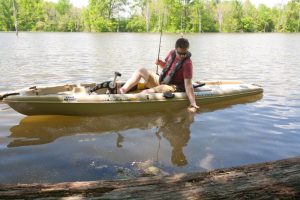
Photo: Kentucky Department Fish and Wildlife
The Kentucky Department of Fish and Wildlife Resources has opened more land for public use.
The properties are in Gallatin, Nicholas, Owen, Pulaski and Wayne counties.
Rockcastle River Wildlife Management Area (WMA) in eastern Pulaski County is the largest of the new WMAs and will offer hunters, anglers and wildlife watchers outstanding recreational opportunities.
The WMA abuts the Daniel Boone National Forest to the south and east. Two areas will remain closed while abandoned gas wells are being permanently sealed along Acorn-Ano Road and Buren Turner Road. No admittance signs, orange flagging and orange paint will mark the off-limits areas.
Visitors to Rockcastle River WMA will find it primarily forested. About 30 percent of the area is open land. Several ponds ranging from half an acre to almost 6 acres are scattered across the property. Daily creel limits on the WMA are 10 bluegill or other sunfish, four catfish, 15 crappie and one bass longer than 15 inches.
Rockcastle River WMA is not listed in the current Kentucky Hunting and Trapping Guide. It will be open for hunting under statewide regulations for squirrel and other game with some exceptions. The modern gun deer season will be open for two consecutive days starting the second Saturday in November. The area will be closed for all muzzleloader deer, grouse and bobwhite quail seasons.
No general fund tax dollars were used in the project.
- Meadow Creek WMA in Wayne County is another new offering in the Southeast Region.
The property is off KY 1619 about 20 minutes northeast of Monticello. The terrain is flat and much of the property is planted with new trees but there are mature woods along the property’s western edge.
Meadow Creek WMA is open for hunting under statewide regulations except the early muzzleloader deer and modern gun deer season are closed.
- Stephens Creek WMA in Gallatin County and a tract at John A. Kleber WMA add more opportunity in the Bluegrass Region.
Stephens Creek WMA is named after the creek that runs along its eastern boundary.
The area is mostly forested and features steep hillsides with some open ridgetops. Offering good populations of deer, turkey and squirrel, it will be open for hunting under statewide regulations, except the modern gun deer and October muzzleloader deer seasons are closed.
No general fund tax dollars were used for the project.
Conveniently situated just off U.S. 127 in southwest Owen County, the tract blends rolling hills and steep wooded hillsides. Cedar stands are interspersed with mixed hardwoods. There are some ridgetop fields and creek bottoms along Gills Branch.
Hunting regulations for the tract will match those in place for the rest of Kleber WMA.
The area boasts a robust deer population, so hunters can expect good deer hunting as well as opportunities for wild turkey. An abundance of oak and hickory trees should lend itself to plenty of enjoyable squirrel hunting. Parking areas are on County Line East Road and Gills Branch Road just off U.S. 127 about 15 minutes north of Frankfort.
- Clay WMA expands with the opening of the Kingsolver tract in Nicholas County. The tract is northeast of Carlisle and about 4 miles by car from the main unit of Clay WMA.
The Kingsolver tract is mostly forested but it also features some open-land habitat. Forested areas will be managed for a mixture of growth stages and beneficial composition with an emphasis on invasive species management. The open land habitat will be managed as early successional old-field habitat.
Hunting regulations for the tract will match those in place for the main tract of Clay WMA. However, it will be open during quota fox hunts and the pheasant hunt.
To reach the Kingsolver tract from Carlisle, follow KY 36 east for 1.5 miles then turn left on Scrubgrass Creek Road. Follow Scrubgrass Creek Road for about 1 mile. From Flemingsburg, follow KY 32 west for about 11 miles. Turn left onto Scrubgrass Creek Road. The property starts ½-mile on the left.
Maps and additional information for these areas and other public lands are available on Kentucky Fish and Wildlife’s website at fw.ky.gov. Click on the “Maps” tab on the department’s homepage and select “Wildlife Management Areas/Public Hunting Areas” from the list of links.
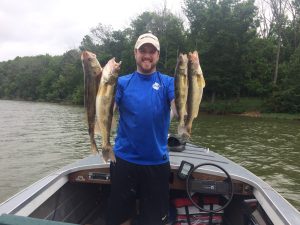
Photo: Kentucky Department Fish and Wildlife
Two employees of the Kentucky Department of Fish and Wildlife Resources recently used the department’s website at www.fw.ky.gov to glean information on catching saugeye.
They used the 5-foot contour maps on the “Find a Place to Fish” to study the bottom of Guist Creek Lake in Shelby County and determine a place to fish. They later fished those areas and caught their first saugeye.
“We trying to provide information on our website to make it easier for anglers to find places to fish and be successful,” said Mike Hardin, assistant director of fisheries for Kentucky Fish and Wildlife. “The “Find a Place to Fish” page allows anglers to sort by county, city, waterbody, access type or even species of fish.”
Many of the waterbodies detailed in the “Find a Place to Fish” page contain important fishing information, such as the 5-foot contour maps. “When you pull these waterbodies up, many of them have the location of fish attractors, species assessments as well as the contour maps. We have the contour maps for most of our smaller state-owned lakes as well as the Fishing in Neighborhoods (FINs) lakes.”
Hardin said the large reservoirs operated by the U.S. Army Corps of Engineers have commercially available maps at tackle shops near the lakes or for sale online. Many of the large outfitters also sell these maps.
“Each entry contains driving directions to all of the ramps on that waterbody,” Hardin said. “They also contain a link to the Fishing Forecast, detailing the fishing for many species in waterbodies across the state.”
Planning a float trip on a stream can be daunting. The “Canoeing and Kayaking” page contains loads of information to help select a place to paddle. You may click on the “Stream Fisheries” tab for detailed information on access sites, lengths of floats and recommended floating levels for streams across Kentucky.
This page also contains photos of each access point and a description of the access. This is invaluable information to paddlers floating a stream for the first time. This page also shows the abundance and size structure of the population of the desirable fish in the stream such as rock bass or smallmouth bass.
The “Canoeing and Kayaking” page also contains a link to the award winning Blue Water Trails series of articles detailing more than 30 different floats across Kentucky. These articles also contain fishing tips for the species in the waterbody as well as a printable map.
“If you are trying to figure out a place for the coming weekend, our website has many resources to help guide you,” Hardin said. “We want people to enjoy our water resources and catch some fish.”
 Weather
Weather Traffic
Traffic @LouisvilleDispatch
@LouisvilleDispatch @LouisvilleDisp
@LouisvilleDisp Subscribe
Subscribe